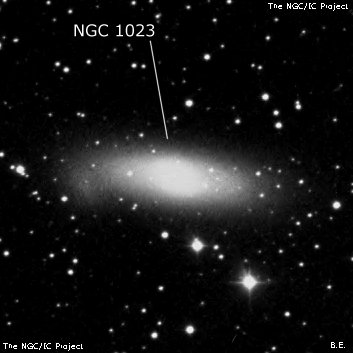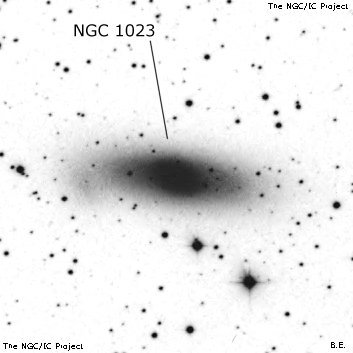NGC/IC Project Restoration Effort
(This is a very very beta version)
NGC1023


Basic Information
Location and Magnitude
Right Ascension: 2:40:24.1
Declination: +39:3:48
Constellation: PER
Visual Magnitude: 9.4
Historic Information
Discoverer: Herschel W.
Year of discovery: 1786
Discovery aperture: 18.7
Observational
Summary description: vB, vL, vmE, vvmbM
Sub-type: E/SB0
Corwin's Notes
=====
NGC 1023 is one of the nearest early-type galaxies in the sky, and is also the
brightest in a group. It has a low-surface-brightness companion ("NGC 1023A"
in the position list) attached on the eastern end. Both galaxies may have
bars, but they are indistinct on the DSS image.
Steve's Notes
=====
NGC 1023
48" (10/25/11): this gorgeous galaxy appeared extremely bright, very elongated 4:1 E-W, ~7'x1.8', with a large, brighter central core that increases to an intensely bright inner core punctuated by a bright stellar nucleus. The outer halo gradually fades at the ends of the extensions. Several stars are superimposed on both sides of the core.
NGC 1023A = PGC 10139, a low surface brightness dwarf companion, is superimposed on the east side (2.4' ESE of center). It appeared as a faint, fairly large, low surface brightness patch oriented SSW-NNE, roughly 1.2'x0.8', and it blends into the main galaxy. Although most of the companion is within the halo of NGC 1023, part of it juts out the southeast edge of the galaxy. The halo of NGC 1023 extends beyond (east) of the dwarf.
18" (8/1/05): at 225x, this striking galaxy appeared very bright, large, very elongated 4:1 E-W, ~4.5'x1.0', though can possibly be traced further with averted vision. The central region has a dramatic, sharp concentration with an unusually bright, oval core. Two mag 14 and 15 stars are superimposed off the west side of the core and a mag 14 star is off the east side.
17.5" (12/8/90): bright, large, very elongated 7:2 E-W, very bright core, almost stellar nucleus. A large fainter halo increases the dimensions to 7'x2'. Two 15th magnitude stars are superimposed on the east and west ends.
13" (12/22/84): very bright, impressive, elongated ~E-W, bright core, stellar nucleus.
8" (11/8/80): fairly bright, bulging bright core, lens-shaped.



